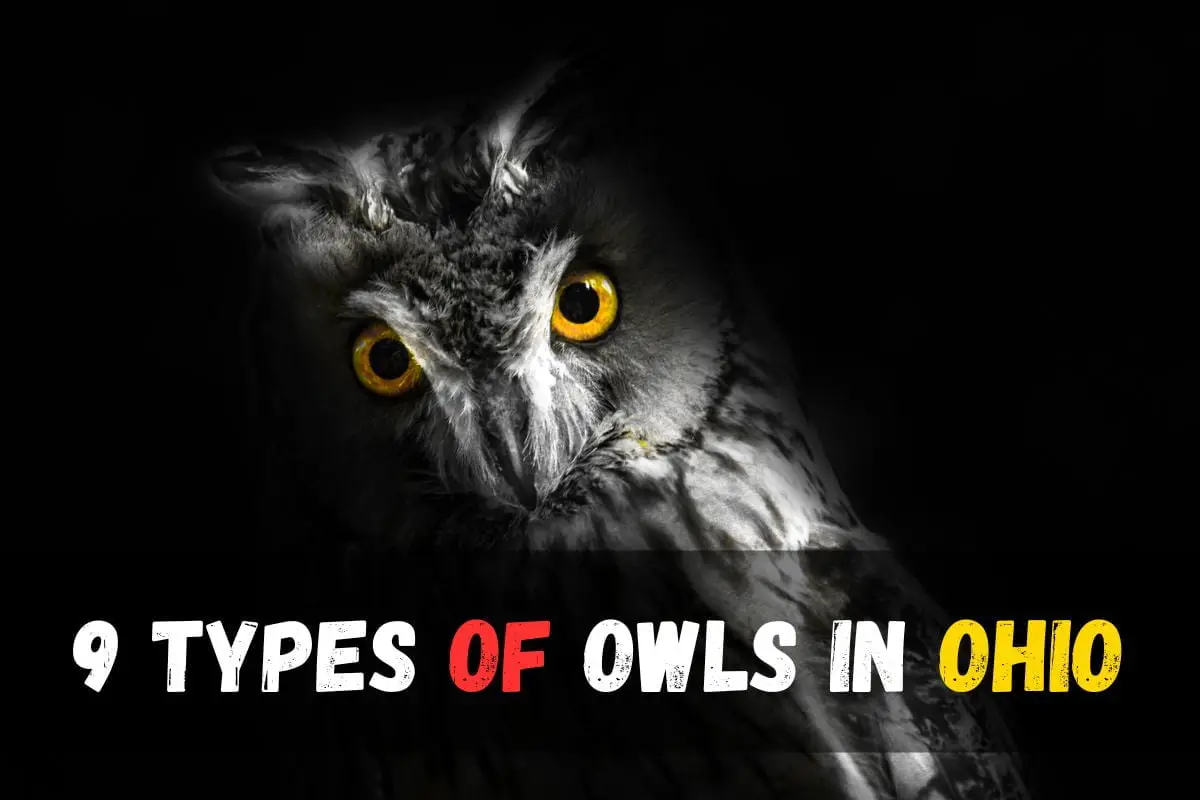9 Types of owls in Ohio
Eastern Screech-Owls
The Eastern Screech-Owl (Megascops asio) is a captivating species of owl native to Ohio, characterized by its small size and distinctive appearance. These owls typically measure between 16 to 25 cm (6.5 to 10 in) in length and weigh between 121 to 244 g (4.25 to 8.5 oz). They sport fluffy feathers in hues of gray, brown, or reddish-brown, with intricate patterns that provide excellent camouflage amidst the trees. Their large, expressive yellow or amber eyes add to their charm, captivating observers with their gaze.

Habitat and Range
Eastern screech owls are adaptable birds that inhabit a variety of wooded and park-like habitats across Ohio. They are year-round residents throughout the state, preferring areas east of the Rocky Mountains. These habitats include deciduous and coniferous forests, residential areas such as city parks, and areas near rivers and streams. They nest in tree cavities and readily take up residence in nest boxes provided by humans. Their range extends beyond Ohio, covering much of North America, including the Eastern half of the United States, Northeastern Mexico, and parts of Southeastern Canada.
16 Types of Owls in Texas
Behavior
Solitary in nature, Eastern Screech-Owls prefer their own company and come together with a partner solely for breeding, typically in April. They establish enduring bonds with their mates and exhibit endearing behaviors during the breeding season. Despite their name, not all Eastern Screech-Owls screech; some emit soft, trilling whistles or eerie descending whinnies that float through the night, adding an ethereal touch to the darkness. They are nocturnal hunters, swooping down from their roosting sites to catch a variety of small animals, including insects, rodents, songbirds, and occasionally small reptiles, birds, and amphibians.
Unique Characteristics and Identification
Identified by their ear tufts, small size, and mottled brown or gray plumage, Eastern Screech-Owls are unmistakable in appearance. There are two color variations gray and red. The gray morph birds blend seamlessly with tree bark, featuring a light gray base color with darker patterns on the back, head, and underside. On the contrary, birds of the red morph display a rich reddish-orange hue as their base color, accompanied by darker grayish-black patterns across their back, head, and chest. Both morphs have white coloration on their underside.
Where to Find Them
Eastern screech owls can be found roosting in tree cavities, nest boxes, or even bird baths across Ohio. They often use the same roosting sites repeatedly, making them relatively easy to locate, especially just before dusk when they may poke their faces out of their roosting sites before embarking on a night of hunting. Urban situations are not uncommon for these adaptable owls, and they may readily take up residence in nest boxes provided by humans.
Diet
Adaptable in their diet, Eastern Screech-Owls consume a wide variety of small prey items, including mammals such as voles, mice, shrews, and rats, as well as insects like beetles, moths, and various invertebrates such as spiders, worms, and snails. They also occasionally indulge in small reptiles, birds, and amphibians, and may even enjoy the occasional fruity delight of berries and fruits found in their surroundings.
Great Horned Owl
Description
The Great Horned Owl (Bubo virginianus) stands as a majestic ruler of Ohio’s nocturnal realm. With its impressive size, ranging from 43 to 64 cm (17 to 25 in), and characteristic ear tufts, it captivates observers with its regal presence. Cloaked in mottled browns and greys, this formidable predator blends seamlessly into its wooded domain, exuding an air of wisdom with its piercing yellow eyes.
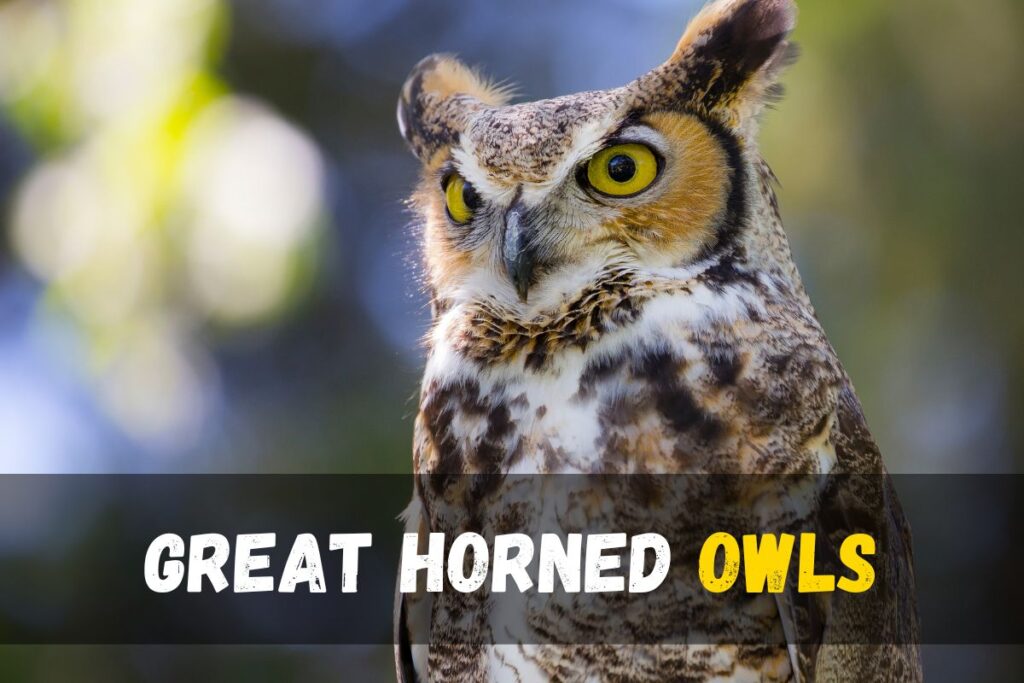
Habitat and Range
Adaptable and resilient, the Great Horned Owl thrives in various environments across Ohio. From dense forests to open fields, and swamps to residential neighborhoods, these owls make their presence known throughout the state. Their range spans across North America, encompassing much of the continent, including Alaska, Canada, the continental United States, and parts of Mexico and South America. Remarkably, they are non-migratory, establishing a permanent presence in their chosen habitats.
Behavior
The Great Horned Owl exhibits a diverse range of behaviors that highlight its adaptability and hunting prowess. Utilizing a combination of perching and gliding, they patrol their territories at night, preying upon mammals and birds on the ground. During the breeding season, they engage in intricate aerial displays and territorial calls, showcasing their courtship rituals. Despite their formidable nature, they also face threats from human interference, including habitat destruction and persecution.
8 Types of Owls in Virginia
Unique Characteristics and Identification
Distinguished by their large size, ear tufts, and finely barred underparts, Great Horned Owls are easily recognizable. Their back, head, and wings sport varying shades of brown, while the underside features a lighter coloration with horizontal barring. Notably, the Arctic population may appear more pale or even white in coloration. Their talons are exceptionally strong and capable of exerting tremendous grip force, making them formidable hunters in the nocturnal realm.
Where to Find Them
Great Horned Owls inhabit a diverse range of environments throughout Ohio, including forests, swamps, and even urban settings. Their distinctive calls, a low “hoo hoo,” often signal their presence, especially during breeding season when they engage in duets. Whether in natural landscapes or human-altered environments like parks and cities, these owls demonstrate remarkable adaptability and resilience.
Diet
As opportunistic hunters, Great Horned Owls possess a wide-ranging diet that includes small rodents, birds, amphibians, reptiles, and even invertebrates. They are known for their fearlessness in preying upon skunks and porcupines, displaying their formidable hunting skills. Their diet varies with prey availability, reflecting their adaptability to different ecosystems and environments.
Barn Owl
Description
The Barn Owl (Tyto alba) is a captivating species known for its ethereal appearance and nocturnal habits. With a length ranging from 12.6 to 15.8 inches and a wingspan spanning 39.4 to 49.2 inches, it presents a slender yet imposing figure. Identified by its distinctive heart-shaped facial disc and beautiful plumage, the Barn Owl is a sight to behold.
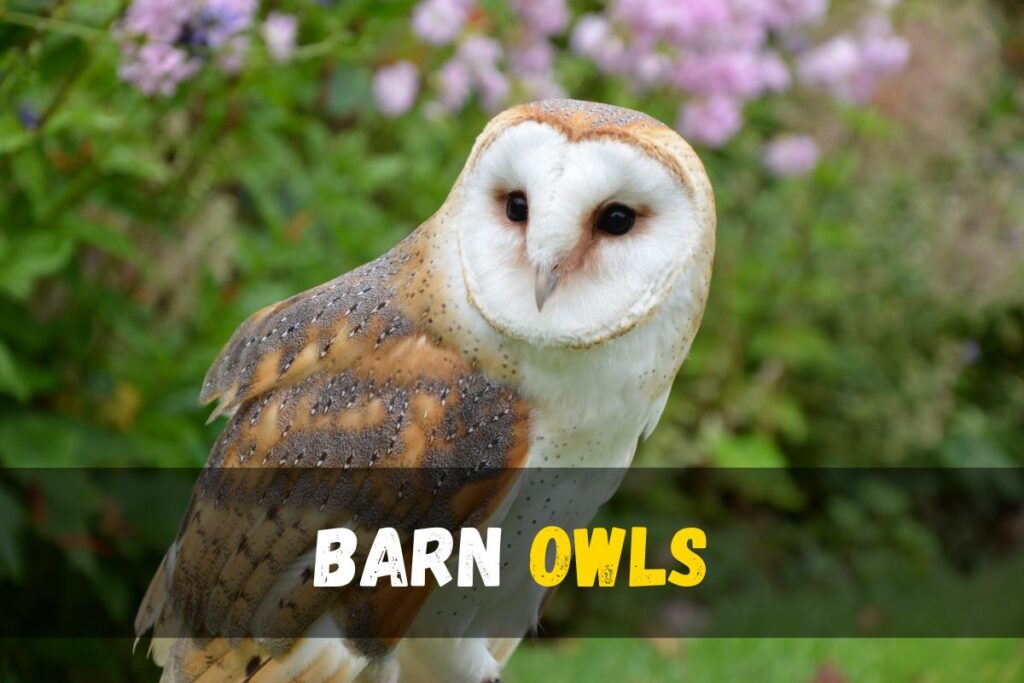
Habitat and Range
Residing year-round in Ohio, the Barn Owl finds sanctuary in a variety of habitats, including fields, meadows, and even urban environments such as cities. They are prevalent across most of Mexico and the United States, with few exceptions in the Northern states. The species exhibits adaptability, often nesting in man-made structures like barns, silos, and church steeples.
Behavior
As nocturnal predators, Barn Owls emerge under the cloak of darkness to hunt their preferred prey: small mammals like voles, mice, shrews, and rats. Their silent flight, aided by exceptional low-light vision and acute hearing, enables them to glide effortlessly over open landscapes, making them formidable hunters of the night.
Unique Characteristics and Identification
The Barn Owl’s pale complexion, characterized by golden tan and gray upperparts contrasted with white underparts, distinguishes it from other owl species. Its haunting call, a shrill scream reminiscent of banshees, adds to its mystique. Notably, the Barn Owl’s ability to regurgitate pellets of undigested material offers insight into its dietary habits and digestive physiology.
Where to Find Them
In Ohio, Barn Owls can be spotted in agricultural fields, grasslands, and open spaces where prey is abundant. They seek out roosting spots in barns, tree cavities, and various structures, utilizing their exceptional sensory capabilities to navigate and hunt effectively.
Diet
Feeding primarily on nocturnal animals, Barn Owls play a vital role in controlling rodent populations. Their diet consists mainly of voles, mice, shrews, and rats, supplemented occasionally by small to medium-sized birds. Their efficiency as hunters, coupled with their unique anatomical features, ensures their success in capturing prey even in the darkest of nights.
Barred Owl
Description:
The Barred Owl (Strix varia) is a medium to large owl species characterized by its round head and distinctive facial disk. Sporting dark brown upperparts adorned with white markings and streaks, this owl possesses a narrow black border on its pale gray face. Both sexes share similar appearances, with females typically being slightly larger than males. With dark eyes and a yellowish beak, the Barred Owl flaps and glides gracefully on its broad wings, showcasing a medium-length, banded tail.

Habitat and Range:
Barred Owls are prevalent across the Eastern United States, Southern Canada, and some parts of the Pacific Northwestern states. They exhibit a preference for forested areas, whether coniferous or deciduous, where tall trees provide ample perching spots and cavities for nesting. Additionally, they thrive in swampy habitats, particularly in the Southeastern states. Their sedentary nature means they are non-migratory, maintaining a consistent presence throughout their range.
Behavior:
Barred Owls are nocturnal creatures, predominantly active during the night. However, they are known to vocalize even during daylight hours, emitting their distinctive “who cooks for you” call. This species nests in tree cavities or utilizes abandoned nests of crows and hawks, showcasing adaptability in their choice of nesting sites. As opportunistic hunters, Barred Owls prey upon a diverse array of small and medium-sized animals, including mammals, birds, amphibians, and reptiles. Their hunting strategy involves perching in strategic vantage points and swooping down to catch unsuspecting prey.
Unique Characteristics and Identification:
Distinctive features of the Barred Owl include its round head, white-marked dark brown upperparts, and dark brown streaks on its pale underparts. Their facial disks aid in sound localization, enhancing their hunting prowess. Notably, Barred Owls possess a memorable call, often described as “who cooks for you,” which echoes through their forested habitats. Their ability to call during daylight sets them apart from many other owl species.
Where to Find Them:
To encounter Barred Owls, venture into mature forests with abundant tall trees and potential nesting cavities. Keep an ear out for their characteristic calls, which they may emit even during daylight hours. Swamps are also prime locations for spotting these owls, particularly in the Southeastern states where they are commonly found.
Diet:
Barred Owls exhibit a varied diet, preying upon small and medium-sized animals found within their habitats. Their menu includes mammals such as mice and voles, as well as avian, reptilian, and insect prey. They may even venture into the water to catch fish and crustaceans. Utilizing their acute hearing, Barred Owls stalk prey near forest rivers and wetlands, showcasing adaptability in their foraging habits.
Long-eared Owl
Description
The Long-eared Owl (Asio otus) is a captivating medium-sized owl species known for its slender build and distinctive long ear tufts. Sporting an orange face and mottled gray plumage, this owl measures between 31 to 40 cm (12 to 16 in) in length, with a wingspan spanning 86 to 102 cm (2ft 10in to 3ft 4in). Typically, females are larger than males, and both sexes exhibit yellow eyes and pale markings around the dark beak.
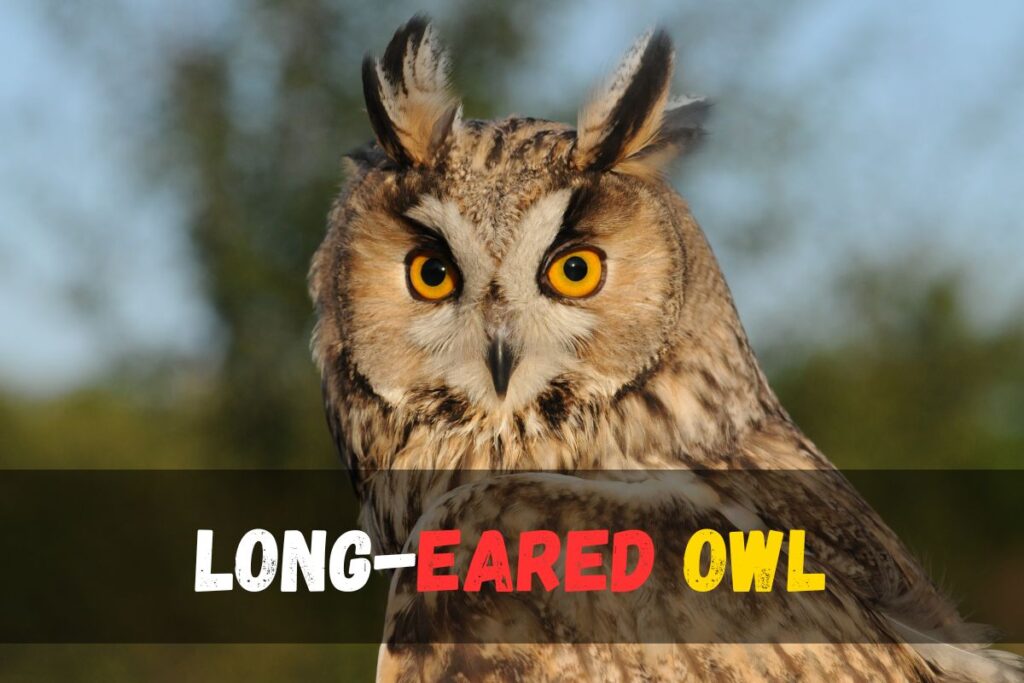
Habitat and Range
Long-eared Owls prefer coniferous and mixed forests near open areas like meadows and bogs, where they can find suitable nesting sites. They nest in abandoned nests of crows, magpies, and hawks, and are found in Canada and much of the lower 48 states, with wintering populations extending into Mexico and the Southern United States.
Behavior
Primarily nocturnal hunters, Long-eared Owls exhibit a remarkable mastery of stealth and silence in their hunting techniques. They glide over open habitats near forests at night, relying on their acute vision and sharp talons to capture small animals like mice, voles, shrews, and occasionally birds.
Their eerie cries, marked by a solitary, brief “Hooo!” at regular intervals, can be heard up to a mile away.
Unique Characteristics and Identification
Long-eared Owls possess several unique features that aid in their identification. These include their long ear tufts, orange facial disks, and long wings with distinctive orange-brown patches near the wingtips. Their slender appearance and mottled plumage, resembling the bark of pine trees, further enhance their camouflage in their woodland habitats.
Where to Find Them
Long-eared Owls are secretive birds that often roost in thick tangles of brush and vegetation, particularly in trees such as willows, cottonwoods, and tamaracks. Their cryptic plumage makes them challenging to spot, but their deep “hoo” calls, frequently repeated in quick succession, can help locate them. In Ohio, they are permanent residents in Northeastern regions and classified as non-breeding elsewhere.
Diet
Feeding primarily on small rodents like mice and voles, Long-eared Owls occasionally supplement their diet with birds, amphibians, or reptiles when food is scarce. They hunt in open areas near forests, patiently perching or gliding close to the ground while scanning for prey. Like other owl species, they swallow their prey whole and regurgitate indigestible parts in pellets.
Short-eared Owl
Description
The Short-eared Owl (Asio flammeus) is a captivating medium-sized owl characterized by its pale brown plumage adorned with dark eye patches on a pale face. Both males and females share similar appearances, with females typically being slightly larger and darker. Notably, these owls possess long wings with distinctive buff patches near the wingtips, and they sport very short ear tufts. Their overall coloration blends seamlessly with the grasslands and prairies they inhabit, featuring light sandy backs and cream-colored undersides with vertical stripes.
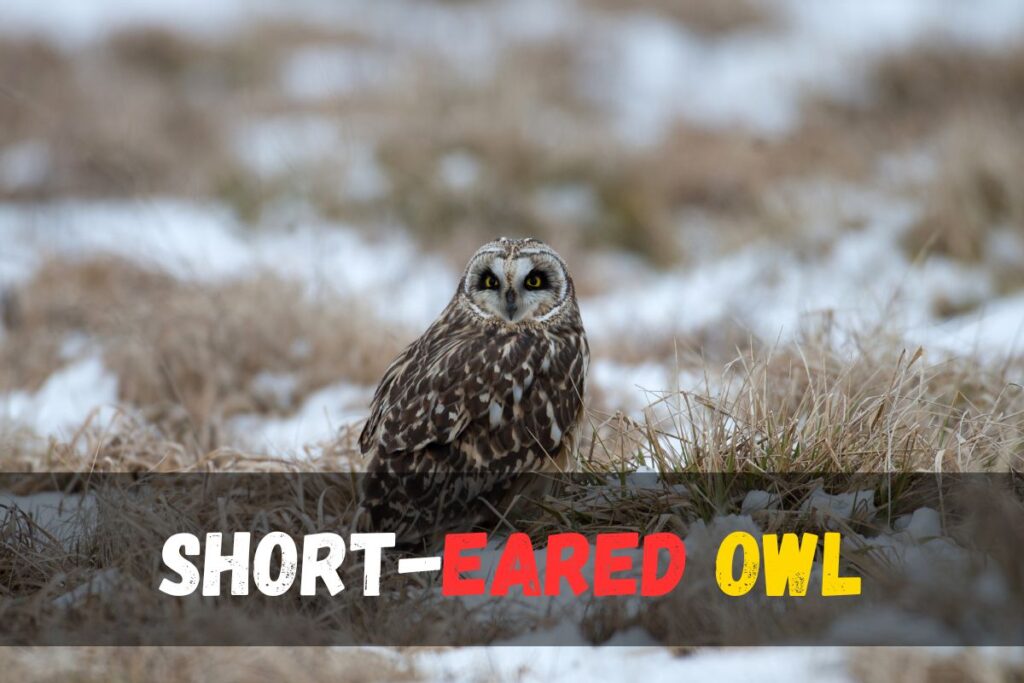
Habitat and Range
Short-eared Owls are adaptable birds with a global presence, inhabiting open habitats such as prairies, grasslands, meadows, and tundras. Their range spans across various continents, including North America, Europe, Asia, Africa, and parts of South America. In North America, they breed in Alaska, Canada, and the northern United States, while they winter in southern regions and migrate as far south as Mexico. Ohio, particularly near Lake Erie, serves as a year-round habitat for these owls, with sightings more common during the non-breeding season from late November to mid-March.
Behavior
Unlike many other owl species, Short-eared Owls are diurnal and crepuscular, meaning they are active during both daylight and twilight hours. They showcase remarkable agility and acrobatics in flight, with rapid wingbeats reminiscent of a moth’s flight pattern. These owls are specialized hunters, preying primarily on small mammals like voles, shrews, and rabbits, but they also consume small birds, reptiles, amphibians, and insects. Short-eared Owls often glide low over open fields, employing their keen eyesight to spot prey on the ground.
Unique Characteristics and Identification
One of the most distinguishing features of Short-eared Owls is their facial disk, which is white with dark and sandy coloration below their bright yellow eyes. Their flat faces are evident during flight and aid in distinguishing them from other species, such as Northern Harriers. Additionally, their preference for nesting on the ground in dense vegetation sets them apart from other owl species, which typically utilize tree cavities or elevated perches for nesting.
Where to Find Them
In Ohio, Short-eared Owls can be spotted in open prairies and grasslands, particularly during the non-breeding season from late November to mid-March. Their crepuscular nature means they are most active at dawn and dusk, although sightings during daylight hours are not uncommon. The vast distribution range of Short-eared Owls across North America offers ample opportunities for birdwatchers to observe these majestic creatures.
Diet
Short-eared Owls have a diverse diet that includes small mammals such as voles, lemmings, shrews, and rabbits, as well as small to medium-sized birds. They are specialized hunters who hunt primarily by flying low over open fields, scanning the ground for prey. Unlike most other owl species, Short-eared Owls spend a significant amount of time hunting in the air, showcasing their exceptional aerial abilities and adaptability to their habitat.
Northern Saw-whet Owl
Description
The Northern Saw-whet Owl, scientifically known as Aegolius acadicus, is a petite yet captivating owl species found in the woodlands of Ohio. Recognized by its small stature, round head, and piercing yellow eyes, this owl boasts a distinctive appearance. Both males and females share similar physical features, with females slightly larger in size. Their brown plumage, adorned with white spots and streaks, blends seamlessly with the forest environment, making them masterful in camouflage.
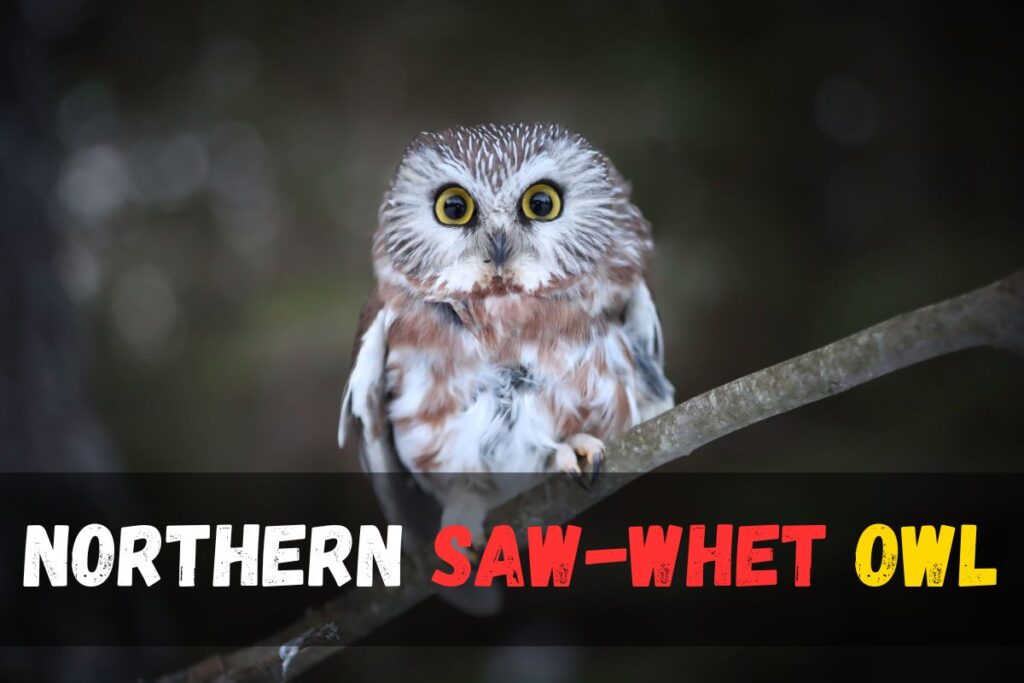
Habitat and Range
Northern Saw-whet Owls inhabit various forested habitats across Ohio, including coniferous and mixed forests. These elusive creatures prefer dense woodlands where they can find suitable roosting spots, such as old woodpecker holes or nest boxes. While they have a breeding range primarily in the northern third of Ohio, they have a non-breeding range throughout the rest of the state. Beyond Ohio, their range extends across North America, including parts of Canada, the United States, and even into Mexico during winter months.
Behavior
As nocturnal hunters, Northern Saw-whet Owls exhibit a behavior adapted to the cover of darkness. They are skilled predators, preying upon small mammals like mice, voles, and shrews, as well as insects and occasionally small birds. During the breeding season in March, they practice monogamy, engaging in mating rituals within their forested territories. Despite their diminutive size, they fiercely defend their nesting sites and territories from potential threats.
Unique Characteristics and Identification
Distinctive features characterize the Northern Saw-whet Owl. Their small size, rounded head, and thick white eyebrows set against a brown backdrop make them easily recognizable. Additionally, their unique call, reminiscent of a drawn-out “toot toot,” aids in their identification during late winter and spring months. Juveniles display cinnamon bodies with dark backs and a prominent “V” between their eyes, adding to their charm.
Where to Find Them
Spotting Northern Saw-whet Owls in Ohio requires patience and a keen eye. Preferred habitats include pine stands within forests, where they roost amidst conifers. Observing white-washed branches or listening for their distinctive call can increase the chances of encountering these elusive owls. Notably, they’ve been sighted in both rural and urban areas, showcasing their adaptability to diverse environments.
Diet
The primary diet of Northern Saw-whet Owls consists of small prey items, predominantly mice. However, during migration, they may opportunistically feed on small songbirds. Despite their small size, they face predation from larger raptors and falcons, necessitating cautious behavior during daylight hours. Their preference for roosting in conifers, around 10 feet off the ground, provides them with camouflage and protection from potential threats.
Snowy Owl
Description
The Snowy Owl (Bubo scandiacus) is a magnificent bird of prey renowned for its breathtaking appearance. With a wingspan spanning up to 4.8 feet and weighing between 3.5 to 6.5 pounds, these owls exude an aura of grandeur. Their pure white plumage, punctuated by piercing yellow eyes, renders them an unmistakable sight against the wintry landscapes they inhabit.
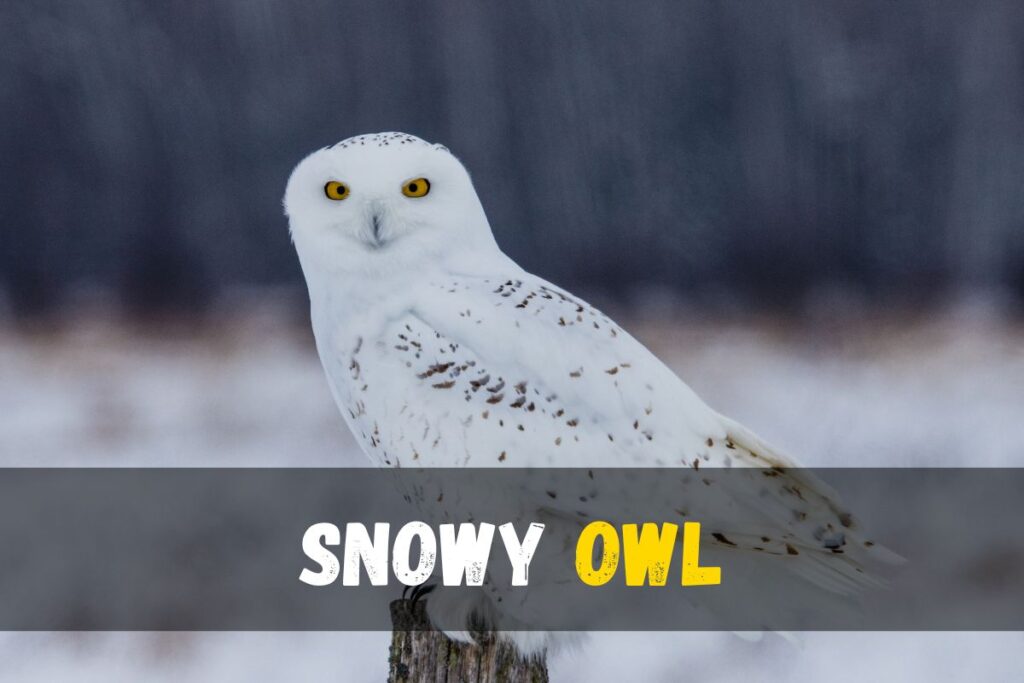
Habitat and Range
Snowy Owls primarily inhabit the Arctic tundra during the breeding season, nesting on elevated spots on the ground. However, during winter, they venture into southern Canada, Alaska, and parts of the continental United States, including Ohio. They are adaptable to a variety of open habitats such as farm fields, grasslands, and even airports.
Behavior
Unlike most owls, Snowy Owls exhibit diurnal behavior, hunting both day and night. They showcase remarkable endurance, capable of going several days without food. Their hunting strategy involves perching to survey their surroundings and then swooping down low to catch small rodents and birds.
Unique Characteristics and Identification
Snowy Owls are characterized by their large size, round heads, and striking yellow eyes. Adult males may range from pure white to white with some dark brown markings, while females and immature birds feature more extensive dark barring. Regardless of age, they maintain a white face. Their broad wings and tail aid in their efficient flight over vast open landscapes.
Where to Find Them
In Ohio, Snowy Owls are rare winter visitors, typically seen during periods of harsh weather conditions or during irruption years when food scarcity in the north drives them farther south. They may be found in open areas like lake shores and airports, where their white plumage stands out against the surroundings.
Diet
Snowy Owls primarily feed on small rodents, particularly lemmings, which are abundant in their breeding areas. Additionally, they prey on birds, with waterfowl being a common menu item. Their adaptable nature allows them to adjust their diet according to the availability of prey in their environment.
Burrowing Owl
Description
The Burrowing Owl (Athene cunicularia) is a diminutive owl species characterized by its small size, long legs, and round head. Sporting striking yellow eyes and a distinctive white chin patch, these owls exhibit animated facial expressions that convey curiosity and playfulness. Their brown and speckled plumage, adorned with some brown barring on pale underparts, adds to their unique appearance.
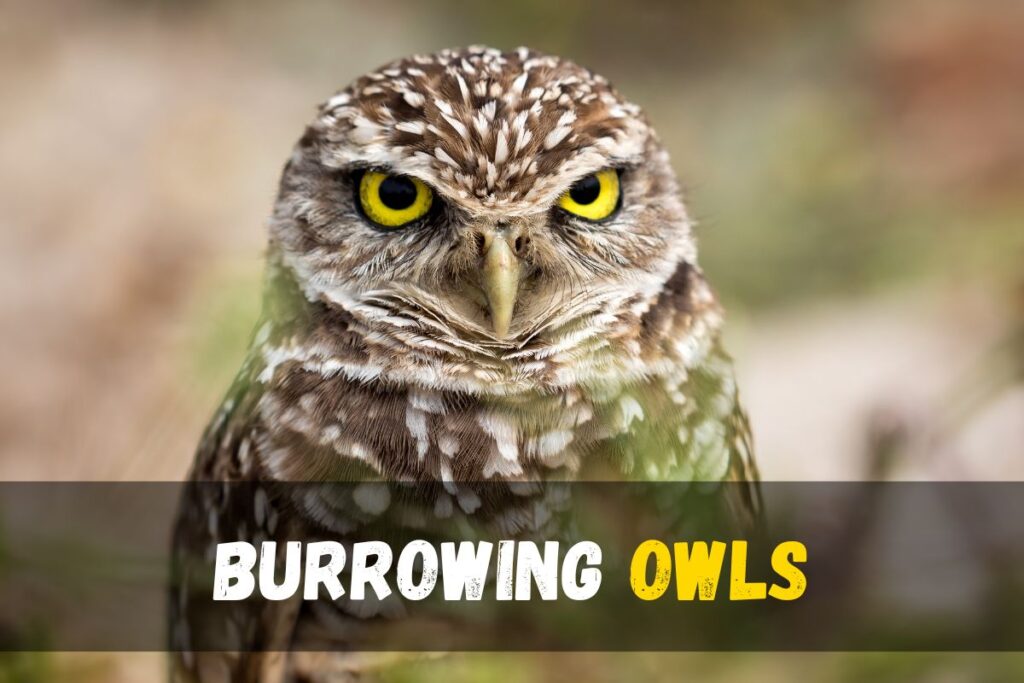
Habitat and Range
Burrowing Owls are commonly found in open habitats such as grasslands, deserts, and agricultural areas. They are summer residents in central-southern Canada, the Great Plains, and much of the western USA. In states like California, Texas, and Florida, they are permanent residents. In Ohio, they are one of the most common owl species, often spotted in grasslands and other wide-open habitats.
Behavior
Unlike many other owl species, Burrowing Owls exhibit both diurnal and nocturnal hunting behavior. They are known to rest in their burrows between hunting sessions and exhibit a unique hunting technique by silently gliding from their perch to catch prey. These owls are also capable of running and flying low to capture small animals on the ground. They are relatively quiet owls, although males make a coo call, and young individuals can mimic a rattlesnake rasp.
Unique Characteristics and Identification
Burrowing Owls possess a compact body with long legs, giving them a distinctive upright posture. Their small size, round head, and terrestrial behavior make them easily identifiable. They nest in burrows made by prairie dogs and other animals, though those in Florida are known to dig their burrows. Their preference for open habitats and their ability to tolerate carbon dioxide makes them stand out among owl species.
Where to Find Them
In Ohio, Burrowing Owls can be found in grasslands, prairies, and agricultural areas. Rather than searching for them in trees, one should look for them hunting on the ground, nesting in underground dens, or perching on fence posts.
Diet
Burrowing Owls have a varied diet, consisting mainly of small mammals such as mice, small rabbits, rats, gophers, and bats. They also feed on lizards and small birds. These owls are known for their ability to wade through shallow water to catch prey and even use animal dung or manure to attract insects to their burrows, demonstrating their resourcefulness in finding food.
FAQ’S
What’s the most common owl in Ohio?
The most common owl species found in Ohio is the Eastern screech-owl. This diminutive owl, known for its small size and widespread presence, is a familiar sight throughout the region. Despite its compact stature, the Eastern screech-owl plays a significant role in Ohio’s ecosystem, preying on insects and small rodents, thus helping to maintain a balanced environment. Its adaptability and prevalence make it a beloved symbol of the state’s diverse wildlife.
Are owls endangered in Ohio?
In Ohio, the population of barn owls, though not abundant, has shown a slight increase in recent years. However, despite this small improvement, the barn owl remains a threatened species in the state. This indicates that while efforts to conserve and protect these majestic birds have had some impact, they are still vulnerable to factors that endanger their survival. Therefore, it’s accurate to say that barn owls are indeed endangered in Ohio, warranting continued conservation efforts to ensure their long-term existence in the region.
Can you hunt owls in Ohio?
In Ohio, individuals interested in hunting owls need to adhere to specific regulations outlined by state law. To engage in owl hunting, enthusiasts must obtain the necessary permit through the Chief of the Division of Wildlife. It’s essential to recognize that owls, belonging to the family Strigidae, fall under the category of birds of prey, alongside other species like falcons, caracaras, hawks, eagles, kites, harriers, and certain vultures, which Ohioans can also hunt under proper licensing. Therefore, while hunting owls is permitted, it is subject to the regulations set forth by the Division of Wildlife to ensure responsible and sustainable practices.
What is the rarest owl to see?
The Pernambuco Pygmy Owl stands out as a remarkable contender for the title of the rarest owl to spot. This diminutive bird inhabits a very limited range, specifically within the northeastern state of Brazil known as Pernambuco. As researchers delve into the enigmatic world of this owl, they face significant challenges due to the scarcity of information about its biology and habitat requirements. Indeed, encountering this elusive species in the wild remains a rare and extraordinary privilege for those fortunate enough to explore its native territory.
What is the biggest owl in Ohio?
The Great Horned Owl reigns as the largest owl in Ohio. With its impressive size and distinctive ear tufts, this formidable predator commands respect in the state’s forests and wooded areas. Known for its deep hooting calls and piercing yellow eyes, the Great Horned Owl is a powerful and iconic symbol of the nighttime wilderness in Ohio.

